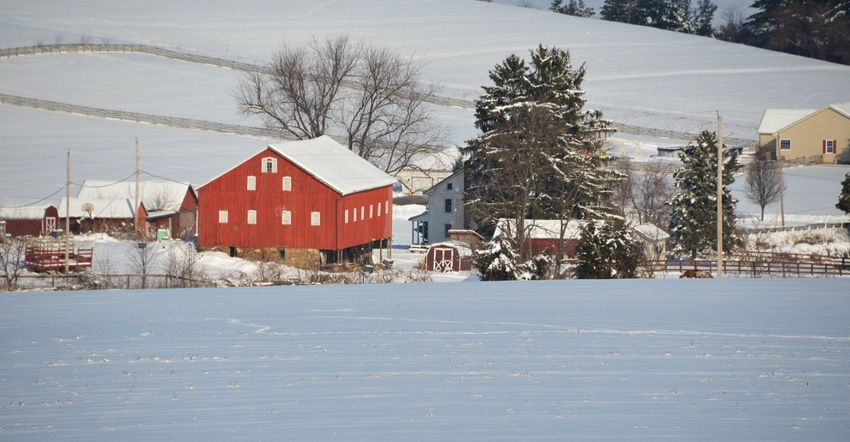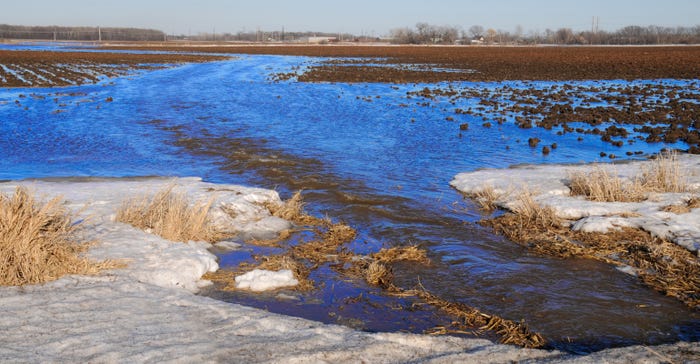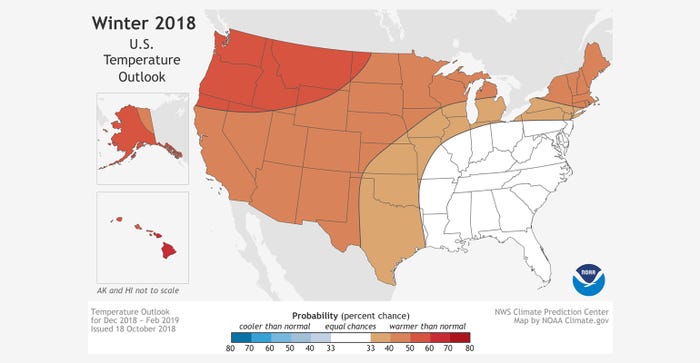November 2, 2018

By Chris Torres
So, is it going to be a cold winter or a warm one? Will we see a deep freeze or a January thaw?
The "experts" are pretty split.
According to the National Weather Service, it's going to be a mild winter for most of the country as there is a 70% to 75% chance of an El Niño developing.
In seasons with an El Niño — the periodic warming of the equatorial eastern Pacific Ocean — winters are generally milder in the north and colder in the south.
"Although a weak El Niño is expected, it may still influence the winter season by bringing wetter conditions across the Southern United States, and warmer, drier conditions to parts of the North," says Mike Halpert, director of NOAA's Climate Prediction Center, in a press release.
The Old Farmer's Almanac, founded in 1792, is predicting the same.
"This winter, we expect to see above-normal temperatures almost everywhere in the United States, except in the Southwest, where we're predicting a colder-than-normal season. It's still going to be wintery, of course, but it won't be an especially frigid year," says a synopsis on the Old Farmer's Almanac website.
But the Farmers' Almanac, founded in 1818, is calling for a cold, frigid winter.
 JANUARY THAW?: The National Weather Service and the Old Farmer's Almanac are predicting a warmer-than-average winter for much of the country.
JANUARY THAW?: The National Weather Service and the Old Farmer's Almanac are predicting a warmer-than-average winter for much of the country.

"The real teeth-chattering arrives mid-February especially in the following zones: Northeast/New England, Great Lakes, Ohio Valley, Midwest and Southeast, yes, even the Southeast will be in the chill zone!" according to a synopsis on the Farmers' Almanac website.
Wetter than average
All three predict a wetter-than-average winter. The National Weather Service is predicting wetter-than-average conditions in the South and Mid-Atlantic and drier-than-average in the northern Rockies, the Great Plains, the Great Lakes region and the northern Ohio Valley.
The Old Farmer's Almanac is predicting a rainy winter for most of the country except for the Southeast, Southern California, the Midwest, and parts of Alaska and Hawaii.
 PRECIPATION PREDICTION: Most of the country will likely see normal amounts of precipitation this winter, according to the National Weather Service, but the Southeast could be wetter than normal.
PRECIPATION PREDICTION: Most of the country will likely see normal amounts of precipitation this winter, according to the National Weather Service, but the Southeast could be wetter than normal.

The Farmers' Almanac is calling for a snowy winter in the Great Lakes, Midwest, New England and the Pacific Northwest. Stormy conditions will persist along the East Coast, especially in March, so the chances of old reliable Punxsutawney Phil seeing his shadow and returning to his hole are pretty good.
Which one is right?
While the National Weather Service admits that predicting winter weather on a seasonal scale is challenging due to many factors, the Old Farmer's Almanac and the Farmers' Almanac rely on what they claim are "time-tested" formulas for weather prediction.
According to the online Mother Nature Network, Robert B. Thomas, founder of the Old Farmer's Almanac, thought that Earth's weather was influenced by magnetic storms on the surface of the Sun and he developed a secret weather prediction formula based on that belief. The book's editors claim an 80% accuracy rate.
The Farmers' Almanac makes its forecasts based on sunspot activity, tidal action of the moon, the position of the planets and other factors.
While the exact formula is a mystery, the only person who knows it is the almanac's official weather prognosticator who goes by the pseudonym Caleb Weatherbee, according to Mother Nature Network.
 WARMER THAN NORMAL: The National Weather Service predicts warmer-than-normal temperatures for much of the northern areas, the West and New England.
WARMER THAN NORMAL: The National Weather Service predicts warmer-than-normal temperatures for much of the northern areas, the West and New England.

The Farmers' Almanac claims an 80% to 85% accuracy rate.
So, which one is right? Only time will tell. But it's always best to prepare for the worst.
You May Also Like




